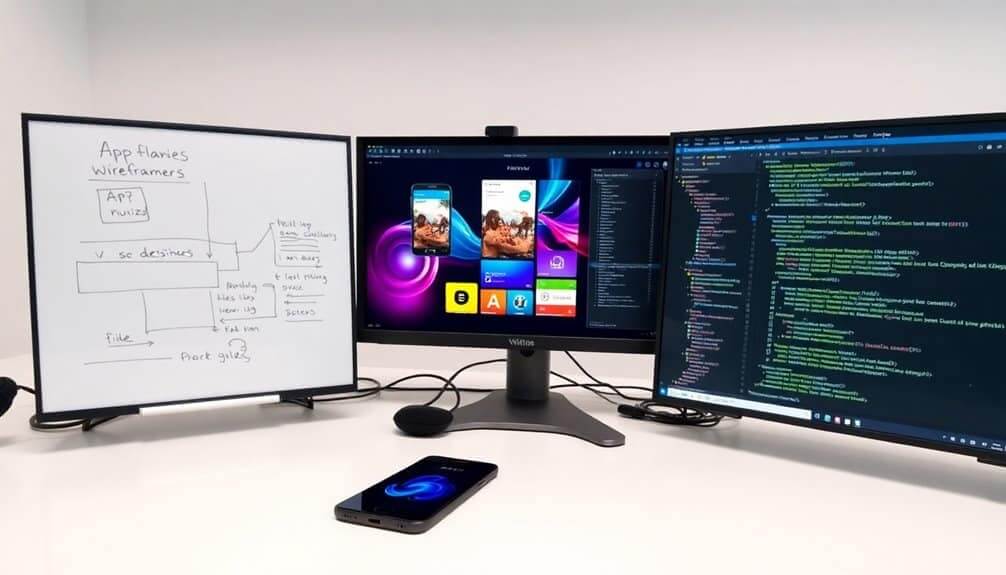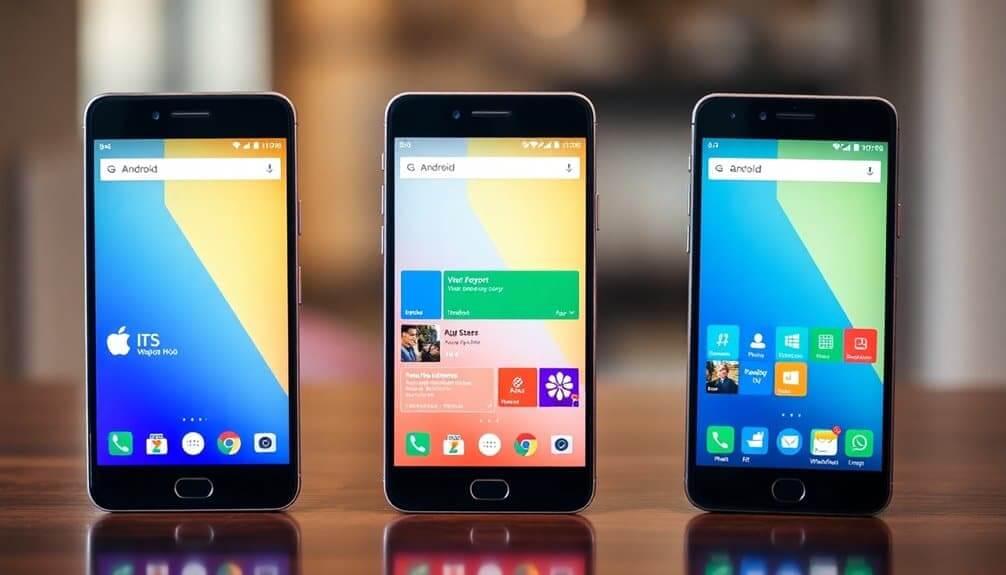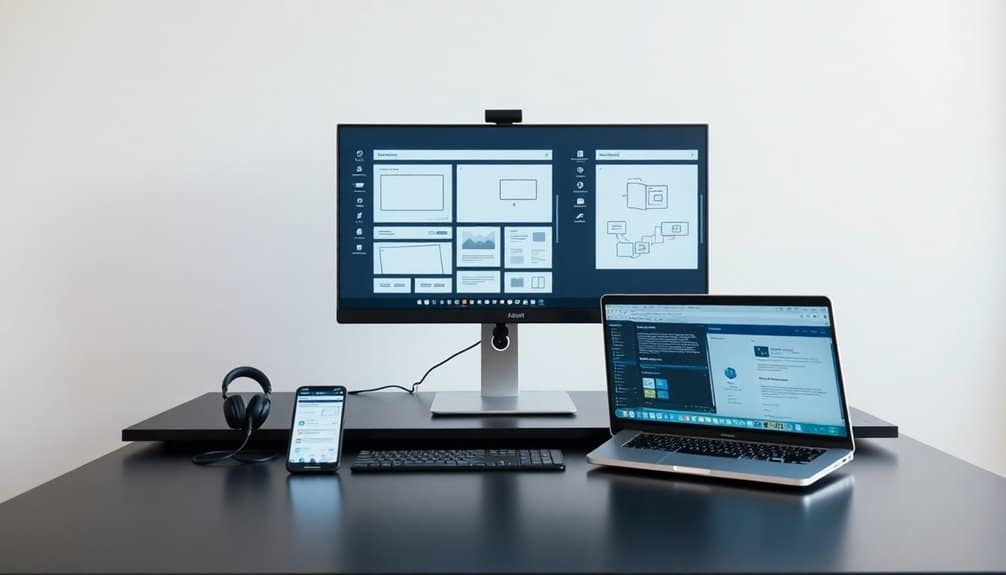You're about to set out on a journey to create a mobile app that transforms your brilliant idea into a tangible software application. Mobile app development is a process that leverages device features and hardware to deliver an optimized user experience. It involves conceptualizing your idea, planning the app's architecture, designing a seamless user interface, developing the app, testing its functionality, and deploying it to app stores. But before you can start building, you need to understand the key components of mobile apps and the steps involved in their development. Let's start with the basics.
Key Takeaways
- Mobile Application Development Definition: Mobile app development is a process that transforms ideas into software applications designed for mobile devices.
- Stages of Mobile App Development: The process includes stages such as conceptualization, planning and analysis, design, development, testing, and deployment.
- App Types: Mobile apps can be categorized into native, web, and hybrid apps, offering flexibility in development and usage.
- User Experience Design: Developing an app with an intuitive and easy-to-use interface is vital to an app's success, emphasizing simplicity and clarity.
- Development Methodologies: Adopting Agile methodologies and iterative development cycles allows the app to evolve with user needs, ensuring ongoing improvement.
What Is Mobile App Development
Dive into the world of mobile application development, and you'll discover a process that transforms ideas into software applications designed specifically for use on mobile devices, such as smartphones and tablets.
This complex process involves creating apps that leverage the unique features and hardware of mobile devices to provide an optimized user experience.
You'll need to ponder various aspects of software development, including UX/UI design, backend development, and quality assurance, to create apps for mobile platforms like iOS and Android.
Mobile application development is critical for many businesses' digital strategies, as it helps them stay on top of mobile trends and meet user needs.
When developing a mobile app, you'll need to focus on app security to protect user data and guarantee the app functions smoothly.
The process includes stages such as conceptualization, planning and analysis, design, development, testing, and deployment. Effective planning involves producing a precise development plan and product roadmap development plan and product roadmap. By understanding these stages and considerations, you can create user-friendly and engaging applications that meet your business goals and user expectations.
Effective mobile app development involves thorough testing to verify the app is free of bugs and performs well across different devices. Additionally, mobile application development can be categorized into different types, including native, hybrid, and web-based development, each with its own set of advantages and technical requirements.
Moreover, mobile apps account for a significant portion of global digital activity, with more than 78% of the population owning a smartphone smartphone ownership.
Key Components of Mobile Apps

As you set out on mobile app development, you'll encounter several key components that substantially impact your project's success.
Your primary focus should be on crafting a user experience design that's both intuitive and visually appealing, while also streamlining your app development process for efficiency and reliability.
Mobile apps can be categorized into native, web, and hybrid apps, offering flexibility in development and usage. A solid foundation starts with choosing the right mobile app architecture, which significantly influences the app's performance, scalability, and maintainability.
Developing an app that incorporates cross-platform capabilities allows targeting a broader user base, including both Android and iOS users, thereby increasing the potential ROI of the app.
User Experience Design
When designing a mobile app, user experience (UX) is vital to its success. You'll want to create an interface that's intuitive and easy to use, taking into account key components that enhance user interaction.
Responsive design is essential, ensuring your app adapts to different screen sizes and orientations.
This involves using flexible layouts, images, and media queries to provide a superior viewing experience. Touch-friendly interfaces and navigation are also pivotal. Design interfaces with elements that are easily tappable, such as buttons at least 44×44 pixels in size, and place interactive elements within easy thumb reach.
Simplify navigation to prevent user frustration.
To further enhance UX, focus on performance refinement. Minimize the use of resources like data and battery power, streamline code, compress images, and use efficient data retrieval techniques. A well-designed mobile UX leads to higher user satisfaction and increased user engagement.
Leverage caching techniques to improve load times and reduce HTTP requests for faster loading. By incorporating these strategies, you'll create a mobile app that's both engaging and user-friendly, utilizing mobile gestures effectively and triggering emotional responses that keep users engaged.
Effective UX design principles, such as usability, accessibility, and credibility, will guide your development process, ensuring your app meets user expectations. Tools like App Inventor can be useful for beginners, providing a web-based visual programming environment to develop mobile apps with a focus on visual interaction.
Adopting a user-centered design approach ensures that your design decisions are influenced by user needs and preferences, ultimately leading to a more successful app.
App Development Process**
Developing a successful mobile app requires a systematic and iterative approach.
It begins with thorough planning, which includes identifying your target audience through market research, defining your app's objectives, and engaging all stakeholders to gather exhaustive requirements.
Conducting a feasibility study confirms project viability, and developing a project plan with timelines, milestones, and resource allocation sets the stage for success.
In the design phase, you create intuitive user interfaces and visualize the app layout through wireframing and prototyping.
A robust and scalable architecture supports app functionality and performance, incorporating various app components such as activities, services, broadcast receivers, and content providers to ensure seamless user interactions.
During development, focus on both front-end and back-end development, using modular and reusable code and version control systems like Git. Continuous integration automates testing and build processes. This phase also involves understanding the importance of cross-platform compatibility.
Adopting Agile methodologies and iterative development cycles guarantees your app evolves with user needs.
Testing, including usability and performance tests, guarantees app quality.
Finally, deploying the app and maintaining it through regular updates and fixes completes the development process.
Consulting with app development experts can provide valuable insights and guidance throughout these stages, leading to a successful mobile app.
Steps in Mobile App Development
Mobile app development involves a series of critical stages that guide an app from its conception to its deployment and ongoing maintenance.
When you initiate creating a mobile app, you start with strategy, defining your product's goals and requirements. You gather information about the market, competitors, and target audience, choose the tech stack, platform, and application features, estimate the cost, and select a monetization model.
Next, you move into analysis and planning. Analyzing market data to produce a precise development plan includes creating a product roadmap and prioritizing app requirements into delivery milestones. You define the minimum viable product (MVP) and identify use cases, capturing detailed functional requirements. Just as an outline helps organize ideas and structure in writing, a clear strategy organizes goals for the app's development process.
The design and development stage involves designing the user interface and user experience, implementing app features, and developing the front-end and back-end of the mobile application. It is crucial to consider screen sizes and hardware specifications when developing scalable mobile apps to ensure compatibility and user satisfaction. Effective app development requires a deep understanding of mobile platform capabilities.
Finally, testing and deployment guarantee that your app is functional, secure, and usable, before releasing it to the market.
Tools and Technologies Used

The choice of tools and technologies used in mobile app development plays a crucial role in determining the app's functionality, performance, and success.
When deciding on the development approach, you have to ponder cross-platform frameworks and development ecosystems that best suit your needs.
Cross-platform frameworks such as Flutter, React Native, Ionic, and Xamarin allow you to develop apps for multiple platforms using a single codebase.
These frameworks offer various benefits, including cost efficiency, rapid development, and high code reusability.
Three key points to ponder when choosing a cross-platform framework:
- Development Language: Flutter uses Dart, React Native uses JavaScript, Ionic uses HTML, CSS, and JavaScript, while Xamarin uses C# and .NET.
- Platform Targeting: Verify the framework supports the platforms you want to target, such as iOS, Android, Web, or desktop.
- Performance: Assess the framework's performance, with Flutter and Xamarin offering near-native performance, while Ionic may be slower due to its web-based approach.
Additionally, consider the mobile economy's growth, as it has significantly increased the demand for versatile and efficient mobile development frameworks. Mobile app frameworks can be categorized into three main types including Native, Hybrid, and Web-based frameworks.
The mobile app development landscape is dominated by Apple and Android apps, making it essential to choose a framework that supports these platforms.
Understanding these factors helps you make an informed decision that aligns with your project requirements and goals.
Mobile App Development Process

Mobile App Development Process involves several key phases that guide your app from concept to launch.
Project Initiation and Planning is the first step, where you define project objectives, conduct market research, set measurable goals, determine resource needs, and create a development timeline. This involves identifying key performance indicators (KPIs) that are Specific, Measurable, Achievable, and Relevant to assess the project's success.
This foundational stage lays the groundwork for your mobile app roadmap, outlining the project's scope and direction. Effective planning in this stage is crucial as it helps in minimizing costs and time, which are key factors in the mobile app development lifecycle.
Next, you plunge into Design and Prototyping, creating wireframes to visualize the app's design and functionality, building a rapid prototype to test workflows and interactions, and refining the design based on user feedback.
Development and Testing follows, where you begin coding, conduct thorough testing, engage in beta testing, guarantee quality assurance, and make necessary adjustments.
Given the competitiveness of the app market, continuous post-launch support Post-Launch Support is essential for continued user satisfaction and app relevance.
Importance of Cross-Platform Compatibility

Importance of Cross-Platform Compatibility
Achieving seamless integration across various platforms is crucial for the success of your mobile app.
Cross-platform compatibility guarantees that your app works smoothly on multiple devices and operating systems, providing a consistent user experience and enhancing user satisfaction.
By using cross-platform frameworks, you can eliminate the need for multiple versions of an app, reducing development time and resources.
Cross-platform mobile app development is a type of mobile app development service that enables developers to create applications that run on various operating systems without developing separate versions for every single platform using cross-platform frameworks.
Key Benefits of Cross-Platform Development
- Single Codebase: A single codebase allows for faster deployment and simpler updates, reducing development costs.
- Efficiency and Cost Savings: Cross-platform development is faster and cheaper compared to native development, with potential cost savings of up to 30%.
- Wider Audience Reach: Cross-platform apps can be deployed on multiple platforms simultaneously, reaching a broader audience.
However, it's important to weigh the challenges and limitations of cross-platform development.
Potential drawbacks include UI/UX lag and performance delays due to native limitations. The flexibility of a shared single codebase makes it easier to manage updates and ensure consistency across platforms.
Cross-platform app development involves incorporating various methods to accommodate software products on multiple operating systems such as Android, iOS, and Windows.
Best Practices for Mobile Apps

You need to design an effective UI that enhances the user experience and guarantees seamless navigation.
To achieve this, it's vital to test your app for quality, focusing on aspects like responsiveness, load times, and accessibility. Conducting thorough market research Market Research is essential in understanding user needs and preferences, which in turn helps in designing an effective UI and user experience.
Simplifying navigation and maintaining clarity are critical, as they directly influence user satisfaction and engagementKey UX Principles. Furthermore, integrating secure coding practices into the development process, including Secure Authentication Mechanisms, is crucial for protecting user data and maintaining trust.
Designing Effective UI
Crafting intuitive mobile apps begins with effective UI design, which hinges on understanding the unique challenges and opportunities of mobile platforms.
When designing your app's UI, you need to focus on simplicity, clarity, and accessibility.
Simplicity is key to a great user experience.
- Simplify Navigation:
- Certify navigation is intuitive and easy to understand.
- Use short and clear labels on navigation menus and tab bars.
- Implement consistent navigation patterns throughout the app.
- Use size, color, and typography to guide user attention.
- Prioritize key content and calls-to-action on the screen.
- Certify a clear visual hierarchy through headings and subheadings.
- Design UI to adapt to different devices and orientations.
- Use flexible layouts and scalable images.
- Certify text size is adjustable for accessibility.
- Given that mobile internet traffic accounts for nearly 60% of all internet traffic, investing in effective mobile UI design is crucial for maximizing user engagement and retention.
- A well-designed UI/UX can significantly increase user engagement and retention, ultimately driving business success.
Effective use of whitespace enhances readability and creates a sense of balance in the interface.
3. Responsive and Accessible Design:
Testing for Quality**
At the core of developing a successful mobile app lies rigorous testing, verifying that the product not only meets but surpasses user expectations.
You need to define clear test objectives that align with your project's goals. These objectives help you focus your testing efforts on the app's most vital areas, such as functionality, performance, security, and usability.
To create effective test objectives, you must understand the app's intended users, its key features, and potential challenges.
This understanding aids in developing appropriate test scenarios and identifying the testing scope. A detailed test plan outlines the approach, timeline, and resources needed for thorough testing.
Incorporating various testing strategies, such as functional, performance, security, compatibility, and regression testing, provides exhaustive coverage of the app's functionalities.
It's also essential to use a combination of automated and manual testing, conduct real-world testing, and prioritize user experience testing.
By doing so, you can verify that your mobile app is robust, reliable, and delivers the expected user experience.
Effective testing strategies, including splitting the testing process, using real devices and emulators, and simulating different network conditions, further enhance the quality of your app.
Maintaining Mobile App Performance

- Optimize Code and Resource Allocation:
- Regularly refactor your code to eliminate inefficiencies and implement efficient algorithms and data structures.
- Use multithreading and concurrency to increase processing efficiency.
- Utilize tools like Google Analytics to analyze user interactions and identify bottlenecks.
- Conduct in-depth app performance audits to detect potential issues early.
- Minimize network requests and use HTTP caching to store copies of frequently accessed resources.
- Compress data before transmission to decrease loading times and enhance user experience.
Frequently Asked Questions
How Long Does It Typically Take to Develop a Mobile App?
As you plunge into mobile app development, think simplicity versus complexity – a basic app takes 2-4 months, while a feature-rich one can stretch to 9+ months, with app complexity directly influencing the development timeline.
What Are the Main Differences Between Native, Hybrid, and Web-Based Apps?
You'll encounter significant differences between native, hybrid, and web-based apps – native apps offer superior performance and hardware integration but require separate development for each platform, while hybrid and web apps provide cross-platform compatibility with some limitations and development trade-offs.
Can Any Programming Language Be Used for Mobile App Development?
You might coincidentally assume that any programming language works for mobile app development, but language barriers and code portability issues arise. Only specific languages like Kotlin, Swift, and Java are ideal for native apps, while others like C#, JavaScript, and Dart cater to cross-platform development.
What Are the Key Factors That Influence the Cost of Mobile App Development?
You'll need to weigh your app's complexity, the development team's location, the features and functionalities you want, and the design and development phases to determine the cost of mobile app development.
Why Is Mobile App Testing a Critical Phase in the Development Process?
Ironically, skipping mobile app testing to save time and money can cost you more in the long run. You should prioritize testing to guarantee a flawless User Experience and leverage Test Automation to catch errors before they impact your users.
Conclusion
You've navigated the world of mobile app development, where ideas blossom into software applications that dance on your fingertips. The process is a harmonious orchestra of conceptualization, planning, design, development, testing, and deployment. By choosing the right tools, embracing Agile methodologies, and prioritizing user experience, you can craft a successful app that meets user needs. Keep refining, iterating, and pushing boundaries – your app is a canvas waiting to be painted with innovation and excellence.



